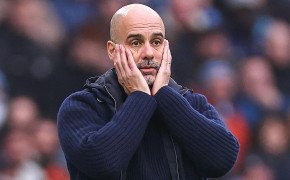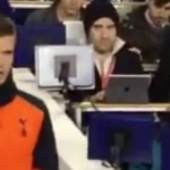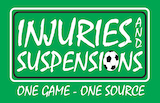Five points in their last three games prior to Sunday’s defeat by Arsenal looks to have finally seen West Ham limp over the line towards Premier League safety.
That the campaign was to going to be a struggle was evident from early on, with then-manager Slaven Bilic apparently given too much sway on transfers and prioritising reputation over current ability. In particular the signing of Joe Hart, by now on a clear downward curve, to ostensibly replace one of the clubs genuine playing assets in Adrian was questionable. It underwrote what looked to be an over reliance on “name” players.
Chicarito has found goals, but at 29 years old hardly represents the future, and as we meander towards the end of the season, to find Pablo Zabaleta and Patrice Evra patrolling the defensive flanks despite a combined age of 69, suggests that historical ability counted a lot for those signing the cheques - and perhaps still does.
A veteran or two can inspire, but coming so soon after the failed January 2017 transfers of Robert Snodgrass and Jose Fonte, it looks far too much like the club has stuck itself with a slightly unevolved policy.
David Moyes arrived to replace Bilic in November and, if rewarded with a new contract for fulfilling the simple remit of avoiding relegation, he may find himself with a solid chance of lasting more than a year at the club, something he has failed to do in a role since leaving Everton in 2013. Has he genuinely improved the Hammers, though?
Bilic was sacked with nine points from 11 games, and Moyes has picked up 26 points from 23 games, so the margins are small but beyond the top line numbers, Bilic’s side were struggling badly. Expected goals hated them and pegged them as genuine relegation candidates at the point that he departed.
Moyes' tenure has been slightly better with results much more so, but they still project very much like a bottom-half team, which makes decisions ahead of next season crucial. If they stagnate, they will almost certainly find themselves once more in among the relegation battlers, and outcome here can often be dictated by small factors related to randomness or luck. Safety can by no means be taken for granted. After all, few considered Southampton, West Brom and Stoke as relegation candidates before this season.
Moyes has found goals in this team, but mainly through a little bit of a hot conversion rate - the kind of thing that is unlikely to sustain. Beneath that, the attacking end looks fairly limp across the whole season with little change in expected rates between the two managers. West Ham simply don’t shoot very frequently and this appears to be a function of Moyes’ risk averse defence-first strategy. However, it seems likely that it will be deemed he has done enough to continue in the job, and having seen the club actively support Bilic’s choices in the transfer market last summer, Moyes may well have significant input this time round.
Win cash prizes for free with our competition!
| User |
Total tips |
Profit | 1 | Yield | Expected prize |
|
|
34
|
49279 | 2 |
+7.57%
|

|
|
|
35
|
47721 | 3 |
+8.99%
|

|
|
|
13
|
40784 | 4 |
+7.71%
|

|
Don't miss out - join our Republik of Mancunia Private Competition today
Moyes' reputation in the transfer market has taken quite a hit since his Everton days. There he built up a huge network, and buying for a specific system he had honed over years he often found players that fitted extremely well.
Manchester United was a different beast, and having inherited a squad that needed rebuilding, it felt as though he was reluctant to make wholesale changes, and gave the players he already had a chance. Only Marouane Fellaini and Juan Mata arrived during his tenure, and while there was possibly a strategic reason to apply caution in a new job with huge expectation, perhaps he went too far in that direction.
That said, both Louis van Gaal and Jose Mourinho have continued to use both players in the four subsequent seasons, so for all Fellaini’s rugged physical qualities and lack of deftness, these were signings that didn’t definitively miss.
Moyes' time at Real Sociedad once more saw few signings and this time with a distinct club-centric flavour. Asier Illarramendi was a returning star, who shone only fleetingly at Real Madrid, Jonathas looked a speculative forward signing off the back of a decent goalscoring season within the league, and perhaps only the loan of Bruma was a deal that provided intrigue, as a young player with great promise.
Then Sunderland. The money went on Didier Ndong and Papi Djilobodji but Moyes’ reputation was scarred later by the loans and cheaper signings, with a raft of his ex-Man Utd and Everton charges arriving to little effect. Very little went right in his tenure there, but the club’s subsequent demotion to League One hardly reflects well on their long-term planning. Moyes arguably faced an impossible task and his hand was forced once the purse strings were tightened.
If anything, the one permanent signing made during Moyes time at West Ham is as confusing as any, with a reported £10m paid to Preston for forward Jordan Hugill in January. The player has enjoyed just 22 minutes on the pitch since. There’s also a question mark around planning: with Moyes yet to be confirmed beyond this season, how much work has gone into targets?
It’s easy to presume Moyes plus West Ham equals transfer market kryptonite, but the buying power of the club means that they should be shopping only a tier or two down from the league’s powerhouses.
With that and the lure of London, West Ham remain a project that has significant potential - as long as the strategy from the top becomes more coherent. Despite the Premier League’s predilection for rehiring from the same small pool of British managers, this could well be Moyes’ last shot at a good job with solid financial backing and some sway for transfers. He needs to do everything in his power to make sure the new players he finds are good enough to make a difference.















